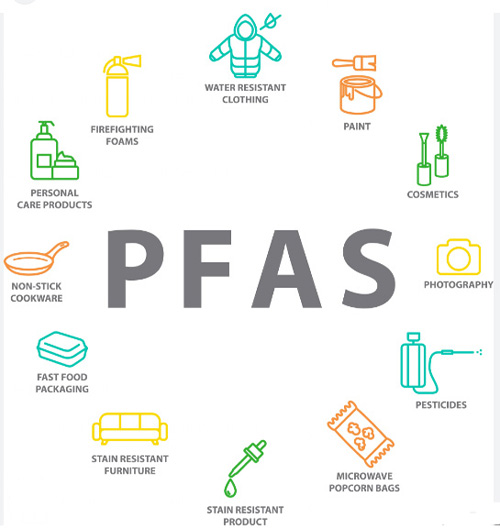Wednesday March 5, 2025 | VICTORIA, BC
by Mary P Brooke | Island Social Trends
Forever chemicals are getting federal attention.
Today, the federal government announced their “additional steps” to address the potential harm of per- and polyfluoroalkyl substances (PFAS), also known as “forever chemicals”.
Those chemicals are commonly found in everyday products including clothing, electronics, food packaging and cosmetics. It can also be in air, dust and drinking water. PFAS can get into the human body through food that has been exposed to pesticides.

A combination of protecting the health of Canadians and safeguarding the environment was the approach today by Minister of Environment and Climate Change Steven Guilbeault in an announcement that was preceded by a technical briefing.
“Today, the Government is taking a significant step forward to better protect workers, firefighters, and all Canadians from ‘forever chemicals’,” said Guilbeault.
“Science shows that the ongoing use of PFAS can harm both the environment and human health,” he said.
Regulations:
Canada already regulates a number of PFAS via regulations, such as the Prohibition of Certain Toxic Substances Regulations, 2012.
“With this announcement, we are leading the way with our partners—including Indigenous peoples and industry experts—to protect not only the health of our ecosystems and Canadians but also the resilience of our economy,” said Guilbeault.
“In coming months, we will consult Canadians on proposed federal actions to improve transparency of information on the presence of substances of concern in products, including PFAS. These actions position us among the world’s leaders in tackling harmful PFAS exposure,” said Guilbeault.
What are PFAS’s:
PFAS are a class of thousands of extremely persistent human-made substances. They are used in a wide range of products for their waterproofing, oil resistance or non-stick properties.
Today, the Government is publishing the State of Per- and Polyfluoroalkyl Substances (PFAS) Report. The report concludes that the class of PFAS, excluding fluoropolymers, is harmful to human health and the environment.
Health impacts:
Exposure to PFAS can adversely affect multiple organs and systems including the liver, kidneys, thyroid, immune system, nervous system, metabolism and body weight, and reproduction and development.
In the environment, PFAS are harmful to wildlife and can build up in living organisms. These substances do not break down easily and remain in the environment for long periods of time.
“PFAS have negative effects on our health and Canadians deserve to be protected,” says federal health minister Mark Holland. “Our government is taking action on PFAS to keep Canadians and our environment safe from the harmful exposure to these chemicals.”
In wildlife, PFAS have been shown to cause toxicity to the immune and nervous systems, and general effects on growth, reproduction, and development.
Prioritizing health and environment:
To address these risks, the Government of Canada is taking steps to propose the addition of the class of PFAS, excluding fluoropolymers, to Part 2 of Schedule 1 to the Canadian Environmental Protection Act, 1999 (CEPA).
Through a step-by-step approach, the Government will prioritize the protection of health and the environment while considering factors such as the availability of alternatives.
- Phase 1, starting in 2025, will address PFAS in firefighting foams to better protect firefighters and the environment.
- Phase 2 will focus on limiting exposure to PFAS in products that are not needed for the protection of human health, safety, or the environment. This will include products like cosmetics, food packaging materials, and textiles.
Reporting PFAS:
Beginning in 2025, the Government of Canada will also require manufacturing and other facilities to report the use of PFAS to the National Pollutant Release Inventory. This data will improve understanding of how PFAS are used in Canada, help evaluate possible industrial PFAS contamination, and support efforts to reduce environmental and human exposure to harmful substances.
Canadians are invited to comment on the Risk Management Approach and the Proposed Order to add the class of PFAS, excluding fluoropolymers, to Part 2 of Schedule 1 to CEPA, until May 7, 2025.
The Government of Canada will continue to engage all interested parties over the coming years to protect the health of Canadians and the environment.
Firefighters:
“I am pleased to see the efforts being taken to eliminate the use of PFAS chemicals that are so prevalent in so many of our everyday products,” say Chris Aubrey, Fire Chief, Langford Fire Rescue.
“Firefighters have been raising the alarm about the dangers and hazards of PFAS chemicals for years and these changes are encouraging and will make everyone safer,” says Chief Aubrey.
Quick facts:
- In recognition of growing evidence that adverse environmental and human health effects identified with well-studied PFAS are more broadly applicable to others, the Government has examined PFAS as a class (a group). This approach helps prevent the substitution of one regulated PFAS for an unregulated PFAS that potentially possesses similar hazardous properties.
- The broad use of PFAS, their extreme persistence in the environment, their ability to move locally and over long ranges, and their consequent ubiquitous presence in the environment have resulted in continuous environmental and human exposure to multiple PFAS.
- Fluoropolymers have been excluded from the State of Per- and Polyfluoroalkyl Substances (PFAS) Report as current evidence suggests they may have different exposure and hazard profiles compared to other PFAS. PFAS meeting the definition of fluoropolymers are planned for consideration in a separate assessment.
===== RELATED:
- BC Greens seek fire department gear upgrade for better health protection (March 15, 2024)
- NEWS SECTIONS: HEALTH | ENVIRONMENT










